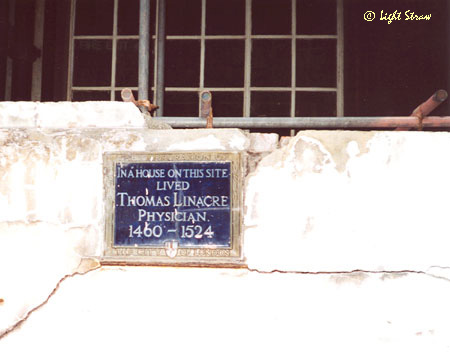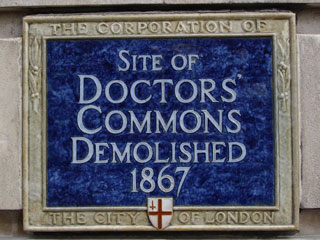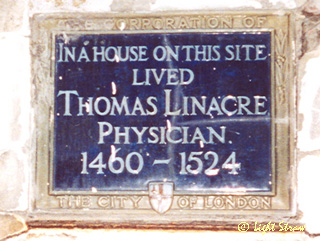...on Knightrider Street.
 |
|
The Doctors' Commons was a familiar name given to the College of Advocates and Doctors of Law which was founded in 1511. It was a requirement for admission as a fellow to have attained the degree of Doctor of Civil Law from either Oxford or Cambridge University. They had shared facilities, such as a common dining/meeting hall, a group of clerks and scribes, and probably a common waiting room.
On Knightrider Street
 |
|
# There were five courts within the Commons:
- The Courts of Arches
- The Prerogative Court
- The Court of Faculties and Dispensations
- The Consistory Court of the Bishop of London
- The High Court of The Admiralty
# Peter Cunningham, Hand-Book of London, 1850
Sherlock Holmes
[from www.evo.org/sherlock/london/doctors_commons.html]
Holmes: "And now, Watson, we shall order breakfast, and afterwards I shall walk down to Doctors' Commons, where I hope to get some data which may help us in this matter."
Thomas Linacre practiced medicine in London and was the appointed physician of King Henry VIII. This was an important and influential position, with notable patients being Cardinal Wolsey, Archbishop Warham and Bishop Fox. In those early days, there were many imposters who were not qualified to practice medicine, and it was through this need to raise standards that the Royal College of Physicians was founded. From his home on this site, Thomas Linacre established the College and became its first president.
 |
|
In 1518 The Royal College of Physicians was founded by King Henry VIII.
"The Royal College of Physicians is a registered charity that aims to ensure high quality care for patients by promoting the highest standards of medical practice. It provides and sets standards in clinical practice and education and training, conducts assessments and examinations, quality assures external audit programmes, supports doctors in their practice of medicine, and advises the Government, public and the profession on health care issues."
Although the Doctors' Commons was demolished in 1867, the site was still referred to by that name as its history had become a part of the area.
Towards the end of the nineteenth century, Bakehouse Court (at 6 Godliman Street) had been built on the site of St. Paul's Bakehouse. The original 'bake house' had supplied bread for the Church. Thus Bakehouse Court continued the area's associations with the practice of law.
By the late 1930s, Bakehouse Court was an empty derelict building on the corner of Carter Lane and Godliman Street. And so in 1938, as the
Telephone Service was rapidly expanding, the GPO applied to compulsory purchase the site, as it was conveniently situated adjacent to GPO South.
Spectacularly, on 4th August 1939 a 48-inch gas main ruptured causing an explosion which demolished the empty Bakehouse Court and caused damage in the surrounding area of St. Paul's.
With the advent of World War Two, the area was to be subjected to more devastation and with this in mind the GPO built its own 'telephone fortress', The Citadel, on the site of Bakehouse Court.
Design, images and text compiled by ©
Light-Straw. Page last updated
14th July 2012. Checked May 2021.
All logos and trade marks are the property of their respective owners
and are used on the Light Straw site(s) for review only. Students and
researchers are recommended to make their own independent enquiries as
to the accuracy of the information contained therein.